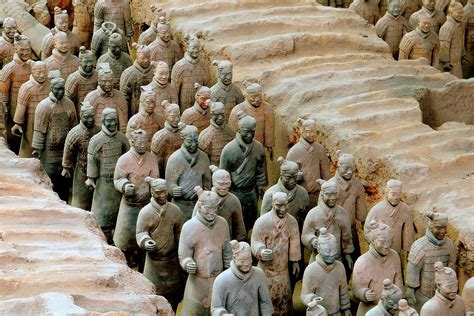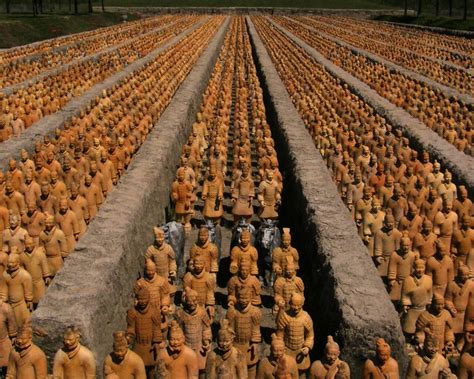first emperor of china tomb excavation Learn about the first emperor of China, his opulent tomb complex and the army of clay soldiers that guard it. Find out why the central tomb remains unexcavated and what . Find 116 listings of used John Deere mini excavators with different models, prices, hours and features. Compare and contact sellers across the US for your preferred machine.
0 · where was qin shi huang buried
1 · terracotta warriors official website
2 · terracotta warriors museum official website
3 · terracotta army official website
4 · qin shi huangdi tomb inside
5 · has qin shi huang's tomb been opened
6 · emperor qin shi huangdi tomb
7 · archaeologists are too scared to open up the tomb of china’s first emperor
Introducing the robust and versatile 1.8 ton mini excavator, engineered to tackle a myriad of tasks with precision and efficiency. This compact powerhouse is designed to deliver maximum performance in tight spaces, making it an ideal choice for construction sites, landscaping projects, utility work, ag and more.
where was qin shi huang buried
It appears that the mission of this Terracotta Army was to guard the nearby mausoleum of Qin Shi Huang, the formidable first emperor of the Qin dynasty who ruled from . Learn about the first emperor of China, his opulent tomb complex and the army of clay soldiers that guard it. Find out why the central tomb remains unexcavated and what . Learn the reasons why the underground palace of the First Qin Emperor remains unexcavated, such as limited technology, deep depth, long time, and environmental risk. Find . Learn about the lavish and mysterious Qin Shi Huang tomb, the burial place of the first emperor of China. Discover how he built his mausoleum to resemble his capital, filled it with treasures and a terracotta army, and .
Learn about the history and mystery of the mausoleum of China's first emperor, Qin Shi Huang, and his terracotta army. Explore the exhibition of archaeological discoveries, the underground palace, and the satellite tombs. Archaeologists have unearthed a 16-tonne coffin and a lavish funerary collection at the Terracotta Warrior complex of China’s first emperor. The tomb is likely the burial of Prince .
skid steer for sale goshen ny
Qin tomb is the burial place of the first Qin emperor, who unified China and built the Great Wall. It contains a vast underground palace, a terra-cotta army, and other treasures, but the tomb itself remains unexcavated. Learn about the discovery and excavation of the terracotta army of the first emperor of China, Qin Shi Huang, at his burial complex in Xian. Find out how the figures were made, .The mausoleum of Qin Shi Huang, the first emperor of the Qin dynasty, is a large tomb complex with a pyramid-shaped mound and a necropolis of terracotta soldiers. It is a UNESCO World Heritage Site and a cultural symbol of ancient China. It appears that the mission of this Terracotta Army was to guard the nearby mausoleum of Qin Shi Huang, the formidable first emperor of the Qin dynasty who ruled from 221 to 210 BCE.

Learn about the discovery and excavation of the massive tomb complex of Qin Shi Huangdi, who declared himself the first emperor of China in 221 B.C.E. See the terracotta warriors, the tumulus, and the underground chambers that reveal his vision of an eternal empire. Learn about the first emperor of China, his opulent tomb complex and the army of clay soldiers that guard it. Find out why the central tomb remains unexcavated and what mysteries it may reveal.
Learn the reasons why the underground palace of the First Qin Emperor remains unexcavated, such as limited technology, deep depth, long time, and environmental risk. Find out what is buried inside the mausoleum and how to visit the terracotta warriors pits. Learn about the lavish and mysterious Qin Shi Huang tomb, the burial place of the first emperor of China. Discover how he built his mausoleum to resemble his capital, filled it with treasures and a terracotta army, and searched for immortality. Learn about the history and mystery of the mausoleum of China's first emperor, Qin Shi Huang, and his terracotta army. Explore the exhibition of archaeological discoveries, the underground palace, and the satellite tombs. Archaeologists have unearthed a 16-tonne coffin and a lavish funerary collection at the Terracotta Warrior complex of China’s first emperor. The tomb is likely the burial of Prince Gao, one of 50 children of Qin Shi Huang, who unified China in 221 BC.
Qin tomb is the burial place of the first Qin emperor, who unified China and built the Great Wall. It contains a vast underground palace, a terra-cotta army, and other treasures, but the tomb itself remains unexcavated.
Learn about the discovery and excavation of the terracotta army of the first emperor of China, Qin Shi Huang, at his burial complex in Xian. Find out how the figures were made, what they.
The mausoleum of Qin Shi Huang, the first emperor of the Qin dynasty, is a large tomb complex with a pyramid-shaped mound and a necropolis of terracotta soldiers. It is a UNESCO World Heritage Site and a cultural symbol of ancient China. It appears that the mission of this Terracotta Army was to guard the nearby mausoleum of Qin Shi Huang, the formidable first emperor of the Qin dynasty who ruled from 221 to 210 BCE.Learn about the discovery and excavation of the massive tomb complex of Qin Shi Huangdi, who declared himself the first emperor of China in 221 B.C.E. See the terracotta warriors, the tumulus, and the underground chambers that reveal his vision of an eternal empire.
terracotta warriors official website
Learn about the first emperor of China, his opulent tomb complex and the army of clay soldiers that guard it. Find out why the central tomb remains unexcavated and what mysteries it may reveal. Learn the reasons why the underground palace of the First Qin Emperor remains unexcavated, such as limited technology, deep depth, long time, and environmental risk. Find out what is buried inside the mausoleum and how to visit the terracotta warriors pits.
Learn about the lavish and mysterious Qin Shi Huang tomb, the burial place of the first emperor of China. Discover how he built his mausoleum to resemble his capital, filled it with treasures and a terracotta army, and searched for immortality. Learn about the history and mystery of the mausoleum of China's first emperor, Qin Shi Huang, and his terracotta army. Explore the exhibition of archaeological discoveries, the underground palace, and the satellite tombs. Archaeologists have unearthed a 16-tonne coffin and a lavish funerary collection at the Terracotta Warrior complex of China’s first emperor. The tomb is likely the burial of Prince Gao, one of 50 children of Qin Shi Huang, who unified China in 221 BC. Qin tomb is the burial place of the first Qin emperor, who unified China and built the Great Wall. It contains a vast underground palace, a terra-cotta army, and other treasures, but the tomb itself remains unexcavated.
terracotta warriors museum official website
terracotta army official website

The Kato HD25V5 is a mini excavator with zero tail swing, high-powered digging force, and a 4-pump system. It has a bucket capacity of 2.8ft3, a transport weight of 5,512 lbs, and a gradeability of 30°.
first emperor of china tomb excavation|has qin shi huang's tomb been opened